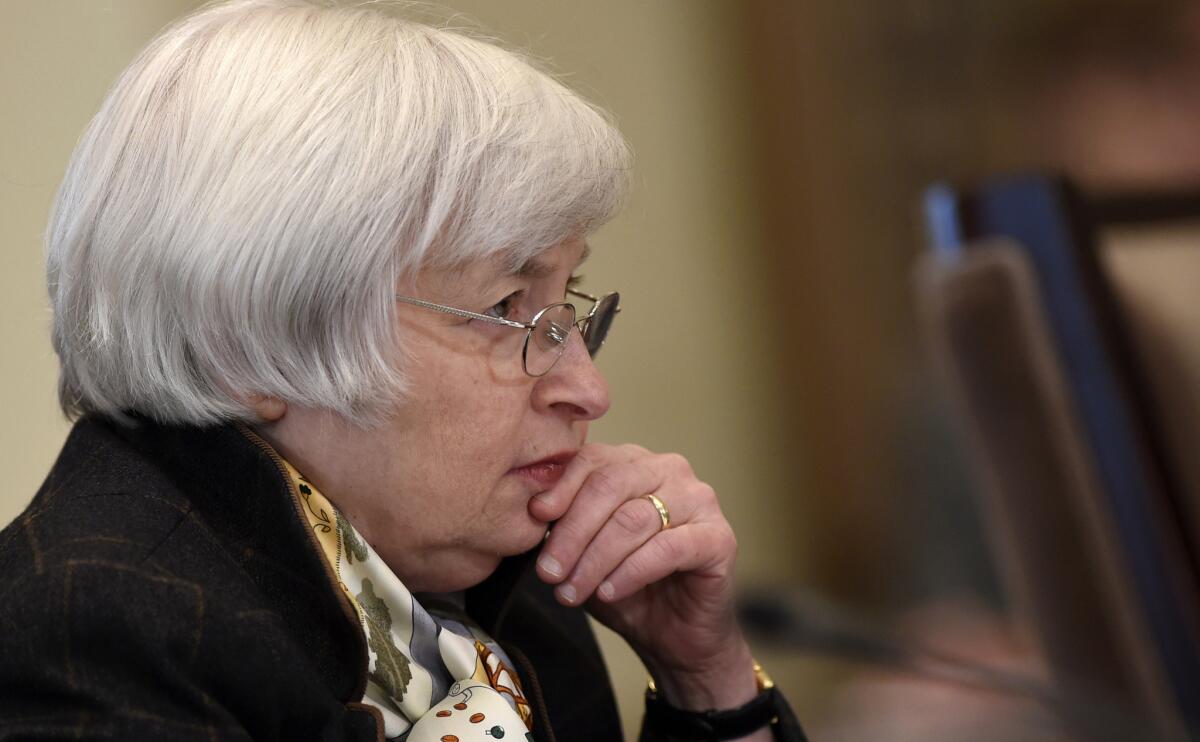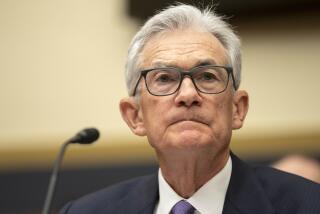Federal Reserve signals an interest rate hike is getting closer

The Federal Reserve signaled Wednesday that its first interest rate hike in eight years is approaching as policymakers stopped indicating that short-term rates would remain near zero for “a considerable time.”
Instead, the Fed said in a statement that, with the economy “expanding at a moderate pace” and “solid job gains and a lower unemployment rate,” the central bank could “be patient in beginning to normalize” interest rates.
“Employment is rising at a healthy rate and the U.S. economy is strengthening,” Fed Chairwoman Janet L. Yellen said at a news conference after the central bank’s two-day policy meeting.
The wording change in the statement, which analysts had expected, indicates that the Fed plans to start raising its benchmark short-term interest rate in the next few months.
The Fed has kept the rate near zero since December 2008 in an effort to stimulate the economy.
Yellen was vague about the timing of the coming increase. She said the Fed was unlikely to act at its January or March meeting, but left the door open after that. The last time the Fed raised rates after a prolonged period, in 2004, the central bank began using the word “patient” five months before the rate hike.
Yellen also emphasized that the Fed would raise rates slowly when it begins.
According to forecasts released by the Fed, most of its policymakers expect to raise rates in 2015. But they don’t expect interest rates to get close to its longer run average of about 3.75% until the end of 2017.
“it’s important to remember that monetary policy will still be very accommodative for a long time,” she said.
Yellen and most of the the other Fed policymakers decided the time was right to change their language on interest rates even though economic conditions are weakening abroad, particularly in Russia.
The vote on the policy statement was 7-3.
The three no votes were unusually high for the Fed. Dallas Federal Reserve Bank President Richard Fisher and Philadelphia Federal Reserve Bank President Charles Plosser dissented; they wanted the Fed to indicate that it would act more quickly.
The other no vote came from Minneapolis Federal Reserve Bank President Narayana Kocherlakota, who opposed indicating that a rate hike was coming because inflation remains low.
Yellen said the weighty issue of deciding when to start reversing the Fed’s last remaining stimulus effort led to the dissents.
“At a time like this where we are making consequential decisions, I think it’s very reasonable to see divergences of opinion,” she said.
Fed officials also are grappling with what they consider to be undesirably low inflation in the U.S.
On Wednesday, the Labor Department reported that the consumer price index declined 0.3% in November. That was the largest drop in six years, fueled by a steep fall in gasoline prices.
Overall, consumer prices rose just 1.3% in the 12 months that ended Nov. 30, well below the Fed’s 2% target for annual inflation.
The Fed said Wednesday that the low inflation rate partly reflected the decline in energy prices.
So-called core inflation, which excludes volatile energy and food prices, was up 1.7% in the year ended Nov. 30.
Yellen said falling oil prices were a positive for the U.S. economy.
“It’s something that’s certainly good for families, for households,” she said.
“It’s putting more money in their pockets, having to spend less on gas and energy, Yellen said. “And so in that sense, it’s like a tax cut that boosts their spending power.”
The Fed’s statement came amid recent financial market turmoil caused by plunging oil prices.
Yellen said Fed policymakers discussed global economic developments, including major problems in Russia caused by the decline in oil prices.
While the Fed is watching the Russian economic situation closely, Yellen said she did not expect a major impact on the U.S.
Russia accounts for less than 1% of U.S. trade and the exposure of U.S. banks is relatively small.
With the U.S. economy, particularly the job market, continuing to improve, Fed watchers had anticipated that the central bank could begin to lay the groundwork for an interest rate hike next year by ditching references to “a considerable time” in its post-meeting statements.
In September 2012, the Fed began trying to reassure financial markets by saying it expected to maintain a “highly accommodative” monetary policy -- a near-zero short-term interest rate -- “for a considerable time after the economic recovery strengthens.”
The term “considerable time” has appeared in Fed policy statements ever since.
In December 2012, the Fed said that the policy would last for “a considerable time” after its bond-buying stimulus program ended.
This week’s two-day meeting of the open market committee was the first since it ended the bond buying in October.
The last time the Fed hiked its key short-term rate was in June 2006, when it raised the benchmark to 5.25%. The following year, as the economy began tumbling toward the Great Recession, the Fed began slowly lowering the rate.
By December 2008, the Fed dropped the rate to near zero and it has stayed there as the economy struggled through the recession and the slow recovery.
The Fed used the word “patient” in 2004 when it laid the groundwork for the first interest rate hike in four years.
The Fed first used the term “considerable period” in August 2003 to describe how long rates would remain low.
In January 2004, five months before it raised rates, the Fed changed its language to say it would “be patient in removing its policy accommodation.”
Fed policymakers kept the “patient” language until May 2004, when they said they believed “that policy accommodation can be removed at a pace that is likely to be measured.”
A month later, the Fed raised its 1% interest rate by 0.25 of a percentage point. It then raised the rate in the same increment at each of its final five meetings of the year.
By the end of 2004, the rate was 2.25%.
For breaking economic news, follow @JimPuzzanghera on Twitter







